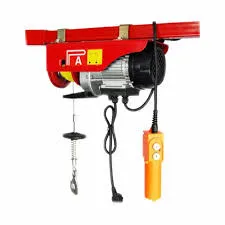


Understanding Chain Hoist Operation An Essential Guide
Chain hoists are indispensable tools in various industries, from construction to manufacturing, providing an effective solution for lifting heavy loads. The operation of chain hoists involves a series of mechanical processes that rely on basic principles of physics and engineering. This article aims to provide a comprehensive overview of chain hoist operation, including its components, functioning principles, safety considerations, and best practices.
Components of a Chain Hoist
A chain hoist generally consists of several key components the chain, pulley, load hook, motor (in electric hoists), and the frame. The chain is the primary lifting mechanism, wrapped around the pulley. The load hook is where the item to be lifted is attached, ensuring safe and secure handling of the load. In manual chain hoists, operators pull on the hand chain to lift or lower the load. Electric hoists, on the other hand, rely on a motorized system to perform these actions.
Operating Principles
The operation of a chain hoist is based on mechanical advantage, which allows a small input force to lift a significantly heavier load. When the operator pulls on the hand chain, the effort is transmitted through the gears of the hoist. This action rotates the pulley, winding the load chain around it and lifting the attached load. The mechanical advantage gained from the gears and pulleys means that a relatively small force can lift a much heavier object.
In electric chain hoists, the process is similar, but the lifting motion is powered by an electric motor. The motor pulls the chain and rotates the pulley, allowing the hoist to lift heavy loads with minimal manual effort. Overload protection is often integrated into electric models to prevent damage from excessive loads.
Safety Considerations
Safety is paramount when operating chain hoists, as mishandling or improper use can lead to severe injuries or equipment damage. Here are several key safety considerations
1. Load Capacity Always check the load capacity of the hoist before operation. Each hoist has a maximum weight it can safely lift, and exceeding this limit can cause equipment failure.
2. Inspection Regular inspections of the hoist’s components, including chains, hooks, and gears, are crucial to ensure they are in good working condition. Look for signs of wear, corrosion, or damage before each use.

3. Proper Rigging Use appropriate rigging techniques when attaching loads to the hoist. Ensure that the load is balanced and secured to prevent it from shifting or falling during lifting.
4. Clear Area Maintain a clear working area around the hoist. This helps prevent accidents and ensures that operators and bystanders are safe while the hoist is in use.
5. Training Ensure that all operators are adequately trained in hoist operation and safety procedures. Understanding the mechanics of the hoist and potential hazards is essential for safe operation.
Best Practices for Efficient Operation
To maximize efficiency when using chain hoists, consider the following best practices
1. Plan Lifting Operations Before starting, plan the lift carefully. Identify potential hazards, determine the best lifting technique, and make sure everyone involved is aware of the plan.
2. Use the Right Hoist Choose the appropriate type of chain hoist for the specific application. Manual hoists are suitable for smaller jobs, while electric hoists are ideal for heavier loads and higher efficiency.
3. Controlled Lifting Operate the hoist in a controlled manner, avoiding sudden jerks or movements. Smooth operation reduces stress on the equipment and minimizes the risk of accidents.
4. Follow Manufacturer Guidelines Always follow the manufacturer's instructions for operation, maintenance, and safety. This ensures optimal performance and longevity of the equipment.
Conclusion
Chain hoists play a vital role in lifting operations across various industries. Understanding their components and proper operation techniques, along with a keen focus on safety, can enhance efficiency and minimize risks. As industries continue to evolve, operators must remain vigilant about equipment maintenance and safety training to ensure safe and effective lifting practices. By adhering to the principles outlined in this article, operators can harness the full potential of chain hoists in their daily operations.



